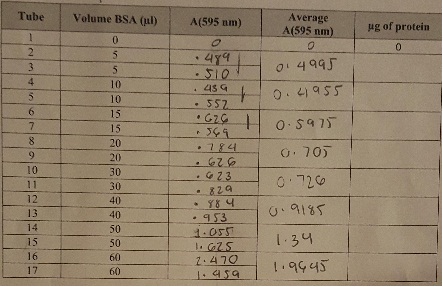Reference no: EM131129162
Enter your raw data for the absorbance measurements of the samples from the bovine serum albumi (BSA) standard curve

1. Calculate the average absorbance value for each of the duplicate samples
2. Then determine the total amount of protein in each of the pairs of tubes. Remember that the stock solution is 1.0 mg/mL or 1.0 ttg/pL. Example: if tube 2 contains 5 ttL of solution you would conclude that it also contains 5 pig of protein since it contains 1.0 gg/pL of BSA.
3. Using a piece of linear graph paper, plot the average absorbance values as a function of the amount of BSA in each pair of tubes. Draw a "best fit" straight line through data points with a ruler. This line should go through the origin since 0 BSA = 0 Absorbance. The line should pass through or come close to most of the data points. You might find, however, that the standard curve becomes nonlinear at high protein concentrations. (Insert a copy of this graph into your lab manual after this page) Note: non-linearity is not slight deviations; instead it is the beginning of a slight curve and should not appear in these data since you are using fairly small concentrations.
4. Discuss the graph with the instructor. If it looks good, you can proceed to the next part of the experiment. If some of the points deviate badly from the straight line, set up new tubes for those amounts of protein and repeat the assay.
5. Once you get a good standard curve, make up a conversion factor relating the absorbance at 595 nm to the amount of protein ( A59,5/µg). This conversion factor is the slope of the line through the linear region of the standard curve and can be calculated from any convenient set of points within the linear region. Record your conversion factor in your lab notebook.
|
What are the advantages of each type of microscopy
: What are the advantages of each type of microscopy? Light vs fluorescence vs. EM and what parts of the cell is best visualized for each?
|
|
Discuss the two pros and cons of activity-based costing
: Discuss the 2 pros and 2 cons of activity-based costing. Give an example of a situation where activity-based costing could be used effectively. Explain your reason.
|
|
What is the expected change in income
: Calculate the income gap for a financial institution with rate-sensitive assets of $20 million and rate-sensitive liabilities of $48 million. If interest rates rise from 4% to 4.8%, what is the expected change in income?
|
|
What portion of time is hand wash facility not being used
: Customers arrive at the average rate of 8 per hour to the Good old Car Wash, where each vehicle goes through a single-lane "Gentle Hands" (real people) wash process that averages four minutes. What portion of the time is the hand wash facility not be..
|
|
Determine the total amount of protein
: Calculate the average absorbance value for each of the duplicate samples and determine the total amount of protein in each of the pairs of tubes.
|
|
Calculate the income gap
: A bank’s balance sheet contains interest-sensitive assets of $280 million and interest-sensitive liabilities of $465 million. Calculate the income gap.
|
|
What is the primary purpose of the risk based capital
: 1. What is the primary purpose of the risk-based capital requirements that Congress enacted as part of the Financial Institutions Reform, Recovery, and Enforcement Act (FIRREA)?
|
|
Prepare an income statement for backus tractor sales
: Backus Tractor Sales The accountant prepared the following list of account balances from the company's records for the year ended December 31, 2013. Prepare an Income Statement for Backus Tractor Sales in Excel. Submit your Excel file.
|
|
Calculate the duration of a commercial loan
: Calculate the duration of a commercial loan. The face value of the loan is $2,000,000. It requires simple interest yearly, with an APR of 8%. The loan is due in four years. The current market rate for such loans is 8%.
|